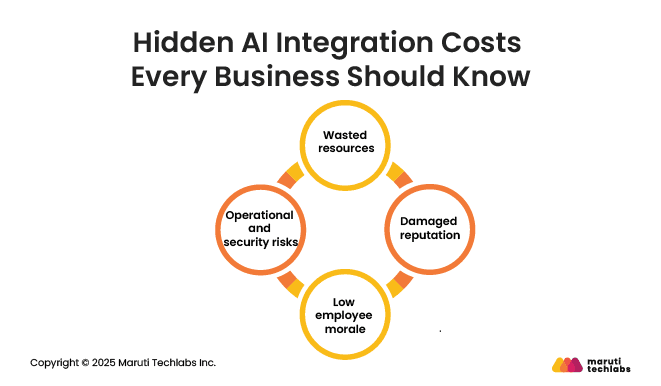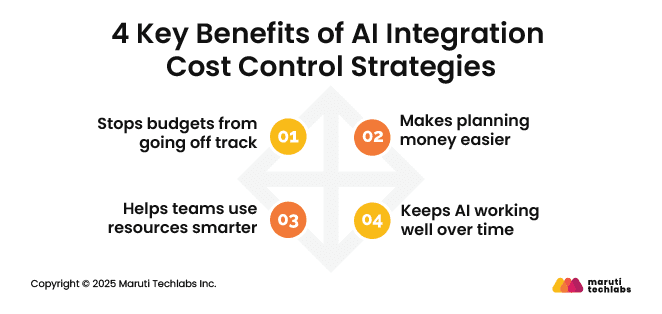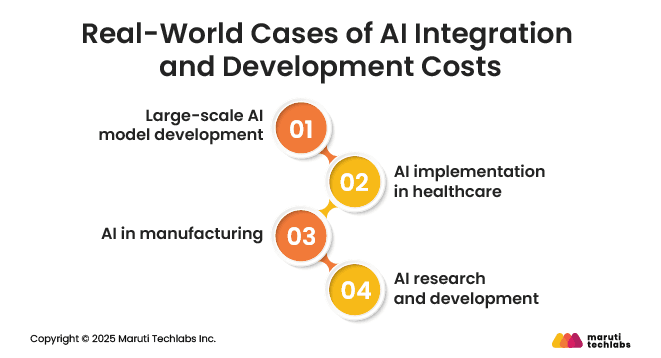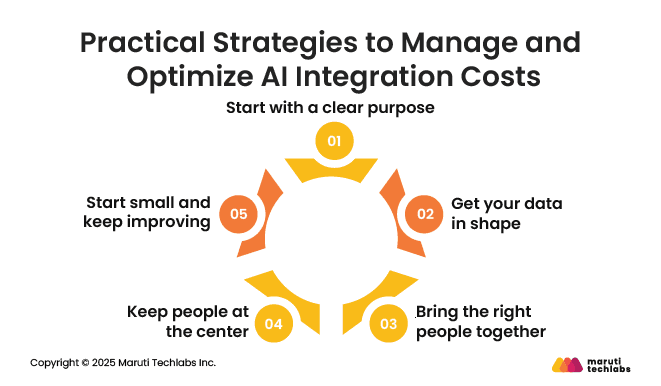

AI Integration Costs Explained: What You Need to Know






Artificial Intelligence is now a core part of business innovation, driving automation, efficiency, and insight across industries. Yet behind all the excitement is a reality many overlook: Integrating AI comes with real costs that are often underestimated. It takes much more than just installing a model. Costs add up quickly through data collection, model training, infrastructure setup, and ongoing maintenance.
According to Gartner, on average, only 54% of AI projects move beyond the pilot stage and actually make it into full use. A McKinsey study found that over 80% of companies haven’t yet seen a meaningful boost in their profits from using AI. The issue is not a lack of advanced tools but the tendency to underestimate the total cost of ownership (TCO) involved in AI data integration and deployment.
Recent insights from IBM’s Institute for Business Value show just how real this challenge is. Computing costs alone are expected to rise by 89% between 2023 and 2025, with 70% of executives blaming generative AI as the main driver. Many even report pausing or canceling projects due to budget pressures.
This blog explores the hidden costs of AI integration, the benefits of managing those costs, real-world examples of AI projects, and practical tips to keep AI integration efficient and cost-effective.
AI integration can unlock significant potential, but the process is rarely smooth. Many organizations begin with intense enthusiasm, only to realize later that technical and operational challenges quietly drive up costs.
What looks like a simple rollout often turns into months of troubleshooting, rework, and adjustments that were never part of the original plan. When an AI project fails to deliver, the financial impact is only part of the problem. The hidden consequences can reach much deeper into the business.

These problems usually arise from a combination of poor or messy data, unclear goals, and difficulty in connecting AI with existing systems. Many companies also struggle with old technology, which makes it harder to use new AI tools effectively.
Most AI failures happen gradually. Minor issues, such as unclear responsibility, inconsistent data, or poor communication between technical and business teams, build up over time and eventually become significant obstacles.
Spotting these challenges early allows businesses to plan realistic timelines, set clear expectations, and create the right conditions for AI to work well. By considering these hidden costs from the start, companies can avoid problems and ensure AI integration is truly successful.
AI integration costs matter for more than just saving money. Controlling costs helps businesses plan, use resources wisely, and make sure AI projects deliver results over time. Here are four key benefits of managing AI costs:

1. Stops budgets from going off track: When you watch your spending closely, it’s easier to prevent surprise expenses. Teams can catch problems early and make adjustments before costs get out of hand.
2. Makes planning money easier: Knowing your AI costs in advance helps businesses plan and predict spending. This makes it simpler to allocate funds and understand the real value of AI projects.
3. Helps teams use resources smarter: Cost control encourages more innovative use of people, time, and technology. Teams focus on what matters most, avoid repeating work, and get the most out of existing tools and systems.
4. Keeps AI working well over time: AI isn’t a one-time project. It needs updates, monitoring, and maintenance. Managing costs carefully ensures systems keep running smoothly and continue to deliver value without unnecessary strain.
Watching costs and planning helps businesses avoid surprises, make smarter decisions, and get the most out of their AI. Controlling costs turns AI into a tool that supports growth instead of draining time and money.
The cost of building and using AI systems can vary significantly depending on the project's complexity, the industry it serves, and the size of the deployment needs. Here are a few real-world examples that show how different these costs can look in practice.

Creating large AI models requires powerful computers and smart teams. For example, building the GPT-3 model cost about $12 million. Future AI models may cost even more, even billions.
Building AI systems for healthcare or self-driving cars takes a lot of time and money. For example, General Motors spent about $10 billion over ten years on its Cruise project before closing it due to high costs and other challenges.
AI tools that help automate factory work or improve quality checks can cost anywhere from $30,000 to $500,000, depending on the size and complexity of the project.
Ongoing investment in AI research continues to grow. Databricks, a company focused on AI and data analytics, has reached a valuation of $62 billion, showing the high value of sustained AI development.
Overall, AI costs depend on goals, data needs, team expertise, and maintenance. As technology advances, these costs will likely continue to change.
Keeping AI integration on budget takes planning, teamwork, and a bit of patience. Here are a few simple steps to help you stay in control of costs while getting real value from your AI projects.

Before jumping into AI, be sure about why you’re doing it. Maybe you want to speed up customer responses or make better predictions. Setting clear goals helps everyone stay focused and prevents wasted effort.
AI depends on good data. Before you begin, check that your data is clean, complete, and organized. Make sure it’s easy to access and actually useful for the problem you want to solve. Spending time here saves a lot of money later.
AI projects work best when people from different teams work together. Include your tech experts, data people, and team members who will use the system every day. This mix helps create solutions that are both practical and easy to use.
Technology alone doesn’t drive change; people do. Involve your employees early, listen to their feedback, and show them how AI can make their work simpler. When people feel included, they’re more open to learning and adapting.
You don’t need to tackle everything at once. Start with a small pilot, see what works, and make improvements along the way. Once it runs well, you can gradually expand. Keep an eye on how the system is performing to make sure it’s meeting your goals.
Taking these small, steady steps makes AI projects easier to manage, more affordable, and more likely to succeed.
AI integration can bring huge benefits, but it also comes with costs that need careful planning. The key to success is understanding both the evident and hidden expenses before starting a project. Businesses that analyze costs clearly and realistically are more likely to get a good return on their investment.
A smart approach includes breaking the project into phases. Start small, deliver results step by step, and gradually expand. This way, organizations can manage risks, learn along the way, and ensure that each stage adds real value. Leveraging Custom AI Development can further help businesses tailor solutions to their needs, optimize costs, and avoid expensive rework by building exactly what aligns with their goals.
Paying attention to critical but often overlooked areas, like data quality and employee training, also makes a big difference in outcomes.
Regularly checking costs and benefits throughout the project helps keep things on track. With careful planning and phased implementation, businesses can typically see positive results within 18–24 months while gaining a competitive edge in the long term.
If you are starting your AI journey, begin with a clear assessment of readiness, prioritize the use cases that matter most, and budget realistically. A thoughtful, step-by-step approach can turn AI integration into a tool that drives growth rather than drains resources.
Learn more about how our AI services at Maruti Techlabs can help you plan, implement, and optimize AI for your business. Contact us to get started.
AI integration involves adding artificial intelligence to existing systems or processes to enable them to work smarter. This can include automating tasks, improving decision-making, or analyzing data faster. The goal is to make business operations more efficient and effective by combining AI with current tools and workflows.
The best AI tools for data integration help collect, clean, and combine data from different sources. Popular options include Talend, Informatica, Microsoft Azure Data Factory, and IBM Cloud Pak for Data. The right tool depends on your data size, sources, and business needs.
The best AI integration platform depends on your goals. Platforms like Microsoft Azure, AWS, Google Cloud AI, and IBM Watson offer powerful features for building and connecting AI systems. Choosing one depends on your budget, team skills, and the types of AI solutions you want to implement.
To integrate AI, start by defining your goals and the problem you want to solve. Clean and prepare your data, choose the right AI tools or platforms, and build or connect models to your systems. Test in small steps, get feedback, and monitor results to improve over time.


